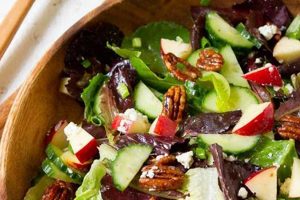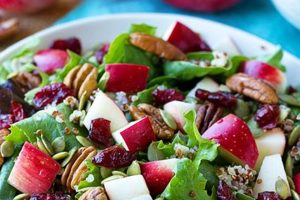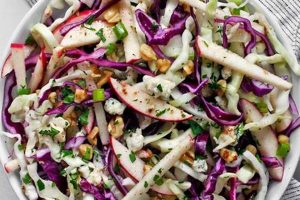A fruit salad featuring apples as the primary ingredient, combined with a sweetened whipped topping, typically Cool Whip brand, characterizes this dish. Variations often include other fruits like grapes and pineapple, as well as additions such as marshmallows, nuts, or cream cheese. A simple version might consist of diced apples, Cool Whip, and a sprinkle of cinnamon.
This dessert’s appeal lies in its ease of preparation and adaptability. Requiring minimal ingredients and culinary expertise, it offers a quick and refreshing treat, particularly suitable for potlucks, picnics, and casual gatherings. Its historical roots likely trace back to the mid-20th century with the rise in popularity of convenience foods and pre-made ingredients like Cool Whip. This dessert provides a palatable way to incorporate fruit into one’s diet, especially for those who might not enjoy fruit in its raw form.
Further exploration will delve into specific recipe variations, nutritional information, tips for ingredient selection and preparation, and suggestions for presentation and serving.
Tips for Creating the Perfect Apple Salad with Cool Whip
Achieving optimal flavor and texture requires attention to detail. The following tips provide guidance for preparing a superior dessert.
Tip 1: Apple Selection: Utilize crisp, tart apples such as Granny Smith, Honeycrisp, or Fuji. These varieties maintain their texture and provide a balanced flavor profile against the sweetness of the whipped topping.
Tip 2: Preventing Browning: To prevent enzymatic browning, coat freshly cut apples with a mixture of lemon juice and water. This helps maintain the fruit’s appealing appearance.
Tip 3: Enhancing Flavor: A touch of cinnamon, nutmeg, or vanilla extract can enhance the overall flavor profile. Consider incorporating extracts that complement the chosen apple variety.
Tip 4: Texture Variation: Adding chopped nuts, such as walnuts or pecans, provides textural contrast and complexity. Toasted nuts offer an intensified flavor.
Tip 5: Incorporating Other Fruits: Grapes, pineapple chunks, or mandarin orange segments complement the apples and add visual appeal. Ensure these additions are fresh and appropriately sized.
Tip 6: Sweetness Adjustment: Adjust sweetness by incorporating a small amount of confectioners’ sugar or maple syrup into the whipped topping. Taste and adjust according to preference.
Tip 7: Chilling: Chill the salad for at least 30 minutes before serving to allow flavors to meld and enhance the refreshing quality of the dish.
Tip 8: Serving Suggestions: Serve the salad in individual bowls or a larger serving dish. Garnish with a sprinkle of cinnamon or a dollop of whipped topping for an elegant presentation.
By following these tips, one can elevate a simple apple salad with whipped topping into a delightful and memorable dessert.
These guidelines contribute to a successful culinary outcome, ensuring a balanced, flavorful, and visually appealing dish.
1. Apples (variety, texture)
Apple selection significantly impacts the final product. Variety dictates flavor profiles, sweetness, and tartness. Texture influences mouthfeel and the salad’s structural integrity. A firm, crisp apple like a Granny Smith offers a tart counterpoint to the sweet Cool Whip and maintains its shape after being mixed. Conversely, a softer apple like a Red Delicious, while sweeter, may become mushy and contribute less textural contrast. The choice depends on the desired balance between sweetness, tartness, and textural complexity.
For instance, a salad emphasizing tartness and crispness would benefit from Granny Smith or Braeburn apples. A sweeter, milder profile might utilize Fuji or Gala. Understanding these varietal characteristics allows for precise flavor and texture manipulation. Consider the interplay between apple and other ingredients. A tart apple balances sweetness from added sugar or marshmallows, while a sweeter apple might require less additional sweetening. This careful consideration ensures a harmonious final product.
Appropriate apple selection is therefore paramount. Ignoring varietal nuances risks an unbalanced or texturally unappealing salad. Informed choices result in a more satisfying culinary experience, highlighting the importance of apple variety and texture as foundational elements. This understanding allows for customization and optimization of the recipe based on individual preferences and desired outcomes.
2. Cool Whip (amount, alternatives)
Cool Whip, a brand of non-dairy whipped topping, plays a crucial role in this dessert, contributing to its creamy texture and sweetness. The amount used influences the salad’s overall richness and sweetness, while alternatives offer varied flavor profiles and dietary accommodations. Understanding these aspects allows for recipe customization based on individual preferences.
- Amount and Texture:
The quantity of Cool Whip directly impacts the salad’s consistency. A greater proportion yields a creamier, richer result, potentially masking the apple’s texture. Conversely, using less emphasizes the apple’s presence and creates a lighter, less dense salad. The desired balance between creamy and fruity dictates the appropriate amount.
- Sweetness Level:
Cool Whip contributes significant sweetness. Adjusting the amount modifies the overall sugar content, impacting the perceived balance between sweet and tart elements. Recipes often compensate for increased Cool Whip with more tart apples or the addition of acidic elements like lemon juice.
- Dairy-Free Considerations:
Cool Whip’s non-dairy nature makes the salad suitable for those avoiding dairy. This characteristic expands the dessert’s accessibility and caters to specific dietary requirements. However, this also impacts the flavor profile compared to dairy-based whipped cream.
- Alternatives and Flavor Profiles:
Alternatives to Cool Whip include homemade whipped cream, Greek yogurt, or coconut cream. These options introduce distinct flavor profiles and textural variations. Whipped cream offers a richer, dairy-based flavor, while Greek yogurt adds tanginess. Coconut cream provides a unique, tropical twist. The choice of topping significantly influences the overall sensory experience.
Careful consideration of Cool Whip quantity and alternative options allows for tailored results. Balancing sweetness, texture, and dietary needs contributes to a more satisfying final product. Choosing the appropriate topping significantly impacts the sensory experience of the dessert, highlighting its importance within the recipe.
3. Sweetness (sugar, alternatives)
Sweetness represents a crucial balancing element within an apple salad featuring whipped topping. The inherent tartness of apples, particularly varieties like Granny Smith, necessitates a sweet component to achieve a palatable flavor profile. Cool Whip, itself a sweetened product, contributes significantly to this aspect. However, the degree of sweetness often requires further adjustment depending on the apple variety’s tartness, individual preferences, and the presence of other ingredients.
Granulated sugar offers the most straightforward approach to enhancing sweetness. Incorporating it directly into the whipped topping ensures even distribution. Alternative sweeteners, such as honey or maple syrup, introduce nuanced flavors alongside sweetness. Honey imparts floral notes, while maple syrup adds a subtle caramel-like complexity. The choice of sweetener impacts not only the perceived sweetness but also the overall flavor profile of the salad. For instance, a salad featuring sweeter apples, like Fuji, might benefit from the nuanced sweetness of honey rather than the direct sweetness of granulated sugar, preventing an overly sugary result. Conversely, a tart Granny Smith apple salad might require the pronounced sweetness of granulated sugar or a combination with honey for optimal balance. Artificial sweeteners offer a low-calorie alternative, though they may impart a slightly different flavor profile. Agave nectar or brown sugar can also be considered for their unique contributions to flavor and sweetness.
Careful consideration of sweetness is essential for a successful outcome. Overly sweet salads become cloying, masking the delicate apple flavor, while insufficient sweetness amplifies tartness to an unpleasant degree. The interplay between apple variety, chosen sweetener, and quantity used necessitates a balanced approach. This careful calibration ensures a harmonious flavor profile and a pleasant sensory experience. Furthermore, the choice of sweetener allows for customization based on dietary restrictions or flavor preferences, demonstrating the practical significance of understanding sweetness modulation within this dessert.
4. Texture (nuts, marshmallows)
Textural contrast contributes significantly to the sensory experience of an apple salad with whipped topping. The inherent creaminess of the whipped topping and the typically smooth texture of the apples benefit from the incorporation of contrasting elements. Nuts and marshmallows offer distinct textural additions, enhancing the overall enjoyment of the dish. Nuts, particularly varieties like walnuts, pecans, or almonds, introduce a desirable crunch and subtle nuttiness. Their firm texture juxtaposes the softer elements, preventing a monotonous mouthfeel. Walnuts, with their slightly bitter edge, complement the sweetness of the whipped topping and the tartness of the apples, while pecans offer a buttery richness. Almonds contribute a neutral, crisp counterpoint.
Marshmallows, on the other hand, offer a contrasting softness. Their airy texture provides a unique textural element distinct from both the apple and the whipped topping. Miniature marshmallows integrate seamlessly, while larger marshmallows create more pronounced textural pockets within the salad. Consider the interplay between these textural additions. Combining nuts and marshmallows offers a complex interplay of crunchy and soft elements, further enriching the sensory experience. However, an excessive quantity of either addition can overwhelm the other components. A balanced approach ensures that each element contributes without dominating.
Careful consideration of textural components is essential for a well-rounded apple salad. A purely smooth and creamy texture, while pleasant, can lack complexity. The strategic addition of nuts and/or marshmallows elevates the dish by introducing textural variety. This understanding allows for customization and optimization of the recipe based on individual preferences and desired textural complexity. The interplay between these contrasting textures enhances the overall enjoyment and sensory satisfaction derived from consuming the dessert.
5. Acidity (lemon juice, other fruits)
Acidity plays a multifaceted role in apple salad with whipped topping, impacting both flavor and appearance. Primarily, acidic elements like lemon juice serve as a preventative measure against enzymatic browning, a chemical reaction that causes cut apples to discolor. The citric acid in lemon juice inhibits this process, preserving the apples’ visual appeal. Beyond this preservative function, acidity contributes a crucial balancing flavor component. The sweetness of the whipped topping, often coupled with additional sweeteners, benefits from a contrasting tartness. This acidity prevents the salad from becoming cloyingly sweet, offering a more complex and balanced flavor profile.
Beyond lemon juice, other acidic fruits can contribute both flavor and textural complexity. Mandarin orange segments or pineapple chunks introduce a burst of juicy tartness while also adding varied textures. Cranberries, while tart, also offer a chewy texture and a vibrant color contrast. The choice of acidic additions depends on the desired flavor profile and overall balance of the salad. For instance, incorporating pineapple introduces a tropical sweetness alongside its acidity, while cranberries offer a more pronounced tartness. Understanding these nuanced flavor profiles allows for careful tailoring of the recipe.
Balancing sweetness and acidity is crucial for a successful apple salad. Overly sweet salads lack complexity and can be overwhelming, while insufficient acidity results in a bland or one-dimensional flavor profile. The strategic use of acidic elements, whether lemon juice or other fruits, ensures a harmonious balance, enhancing the overall sensory experience. This careful consideration of acidity not only preserves the visual appeal of the salad but also elevates its flavor profile, contributing to a more enjoyable and satisfying culinary creation.
6. Spices (cinnamon, nutmeg)
Spice selection significantly influences the flavor profile of an apple salad with whipped topping. While the base recipe offers a pleasant combination of creamy sweetness and apple tartness, incorporating spices adds depth and complexity. Cinnamon and nutmeg, commonly associated with apple dishes, offer particularly complementary flavor profiles, enhancing the overall sensory experience.
- Cinnamon’s Warmth and Versatility
Cinnamon’s warm, slightly sweet, and woody notes enhance the inherent sweetness of the apples and whipped topping. Its versatility allows for usage in both ground and stick form, each offering distinct advantages. Ground cinnamon readily disperses throughout the salad, ensuring even flavor distribution. A cinnamon stick, steeped while the apples macerate, infuses a subtle, pervasive warmth. Cinnamon complements other spices and flavorings, making it a versatile addition.
- Nutmeg’s Aromatic Complexity
Nutmeg offers a warm, slightly nutty, and subtly sweet flavor profile that complements both apples and dairy-based ingredients. Its aromatic complexity adds depth to the salad, enhancing the overall sensory experience. Nutmeg, while often used in conjunction with cinnamon, possesses a distinct character that avoids redundancy. Its presence adds a layer of sophistication, elevating the dessert beyond simple sweetness.
- Balancing Spice Levels
Achieving the correct spice balance is crucial. Over-spicing can overwhelm the delicate apple and whipped cream flavors, while insufficient spicing renders the addition imperceptible. Start with small amounts, tasting and adjusting incrementally. The desired intensity of spice flavor depends on personal preference and the balance of other ingredients. A tart apple variety might benefit from a more pronounced spice presence to counterbalance the acidity, whereas a sweeter apple might require a more delicate touch.
- Spice Incorporation Methods
Incorporating spices effectively ensures even flavor distribution and prevents localized pockets of intense flavor. Mixing ground spices directly into the whipped topping allows for uniform dispersal throughout the salad. Alternatively, spices can be sprinkled over the diced apples before incorporating the whipped topping. This method allows the apples to absorb some of the spice flavor directly. For a more subtle infusion, a cinnamon stick can be steeped in any liquids used during apple preparation. This imparts a gentle warmth without overpowering the other flavors.
The judicious use of spices like cinnamon and nutmeg elevates a simple apple salad with whipped topping into a more complex and flavorful dessert. Understanding their individual characteristics and considering the overall balance of flavors allows for a customized and satisfying culinary experience. Careful spice selection and incorporation enhance the inherent flavors of the core ingredients, creating a more nuanced and enjoyable dessert.
7. Chill time (duration, importance)
Chill time significantly influences the final quality of an apple salad with whipped topping. Proper chilling affects both flavor development and textural stability, enhancing the overall sensory experience. Understanding the impact of chill time allows for optimization of this dessert.
- Flavor Melding
Chilling allows the individual flavors of the apples, whipped topping, and any additional ingredients (spices, other fruits, etc.) to meld and harmonize. This integration creates a more cohesive and complex flavor profile compared to a freshly made, unchilled salad. The flavors become less distinct and more intertwined, resulting in a more unified taste experience.
- Texture Enhancement
Chilling firms the whipped topping, preventing it from becoming overly soft or runny. This is particularly important if the salad includes juicy fruits that might release moisture during chilling. The cooler temperature also enhances the crispness of the apples, providing a pleasant textural contrast to the creamy topping. This interplay of textures contributes significantly to the enjoyment of the dessert.
- Temperature and Refreshment
A chilled salad offers a more refreshing experience, particularly in warmer weather. The cool temperature enhances the perceived sweetness and tartness of the ingredients, creating a more invigorating sensory experience. This characteristic makes chilled apple salad an ideal dessert for picnics, barbecues, and other outdoor gatherings.
- Recommended Duration
A minimum chill time of 30 minutes allows for sufficient flavor melding and texture stabilization. Extending the chill time to several hours, or even overnight, further enhances these effects. However, excessively long chilling periods may cause the apples to lose some of their crispness. The optimal duration depends on the specific recipe and desired outcome, balancing flavor development, textural preferences, and time constraints.
Chilling, therefore, represents a crucial step in preparing apple salad with whipped topping. While often overlooked, this seemingly simple process significantly impacts flavor development, textural stability, and the overall refreshment value of the dessert. Understanding the importance of chill time and implementing appropriate chilling durations ensures a more satisfying and enjoyable culinary experience.
Frequently Asked Questions
This section addresses common inquiries regarding the preparation and characteristics of apple salad incorporating whipped topping.
Question 1: How can browning of apples be prevented after slicing?
Submerging apple slices in a solution of water and lemon juice inhibits enzymatic browning. The citric acid in lemon juice acts as an antioxidant, preventing discoloration while adding a subtle tartness.
Question 2: What apple varieties are most suitable for this type of salad?
Crisp, tart apples such as Granny Smith, Honeycrisp, or Braeburn provide optimal flavor and textural contrast against the sweetness of the whipped topping. These varieties also hold their shape well after being mixed.
Question 3: Can alternative sweeteners be used in place of granulated sugar?
Honey, maple syrup, or agave nectar offer alternative sweetening options, each contributing distinct flavor nuances. Artificial sweeteners provide a low-calorie option but may impart a slightly different taste.
Question 4: What textural additions can enhance the salad?
Chopped nuts, such as walnuts or pecans, introduce a desirable crunch. Miniature marshmallows offer a contrasting softness. The combination of both creates a more complex textural experience.
Question 5: How long should the salad be chilled before serving?
A minimum of 30 minutes allows flavors to meld and the whipped topping to stabilize. Longer chilling enhances these effects but may slightly soften the apples. Optimal chill time depends on individual preference.
Question 6: Can dairy-based whipped cream be substituted for Cool Whip?
Whipped cream offers a richer flavor profile compared to Cool Whip. However, this substitution alters the dessert’s non-dairy characteristic. Greek yogurt or coconut cream provide alternative dairy-free options.
Understanding these aspects ensures a successful outcome, allowing for customization based on individual preferences and dietary requirements.
The following section provides a detailed recipe with step-by-step instructions.
Apple Salad with Cool Whip Recipe
Exploration of this straightforward dessert reveals a nuanced interplay of ingredients and techniques. Careful apple selection, balancing sweetness and acidity, incorporating textural variety, and understanding the impact of chilling contribute significantly to the final product. Spice incorporation adds depth, while alternative ingredients offer customization options based on dietary needs and flavor preferences. Understanding these elements allows for consistent creation of a satisfying and enjoyable dish.
This seemingly simple dessert offers opportunities for culinary creativity. Experimentation with varied apple types, alternative sweeteners, and textural additions allows for personalized interpretations. Appreciation for the subtle interplay of flavors and textures elevates this dish beyond basic categorization, highlighting its potential as a versatile and adaptable dessert option.






